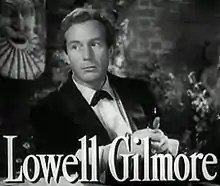Lowell Gilmore
Lowell Gilmore (20 December 1906 - 31 January 1960) was an American stage, film and television actor.
Lowell Gilmore | |
|---|---|
 as Basil Hallward in The Picture of Dorian Gray (1945) | |
| Born | December 20, 1906 Saint Paul, Minnesota, U.S. |
| Died | January 31, 1960 (aged 53) Hollywood, California, U.S. |
| Resting place | Pierce Brothers Valhalla Memorial Park, North Hollywood |
| Years active | (secured) 1929-1958 |
Life and career
Lowell Gilmore first worked as a stage manager on the 1929 Broadway play The First Mrs. Fraser, but got his chance as an actor when he replaced actor Eric Elliott in the play.[1] This was the start to a successful Broadway career in the 1930s with plays like The Wind and the Rain (1934), The Taming of the Shrew (1935) and Leave Her to Heaven (1940). He made his film debut in Jacques Tourneur's war drama Days of Glory (1944) with Gregory Peck, where he was featured in an extensive role as Peck's second-in-command. His second film role was perhaps his most notable: As painter Basil Hallward in The Picture of Dorian Gray (1945), the film adaption of Oscar Wilde's literature classic. Another notable role was the District Commissioner in the Oscar-winning adventure film King Solomon's Mines (1950) with Deborah Kerr.
Although Gilmore was born in the United States, the "suave-looking, wavy-haired supporting actor" often portrayed British characters like doctors, officers and aristocrats.[2] His roles were often dapper and sometimes also cads and villains.[3] One of his best roles was probably as the Duke of Gloucester (the future Richard III) in The Black Arrow (1948), where he played him as a semi-sympathetic and charming, semi-villainous character. While his film roles got somewhat smaller in the 1950s, he played in numerous television series like Alfred Hitchcock Presents and The Jack Benny Program. Gilmore also appeared as Pontius Pilate in the television series The Living Christ Series (1951) and the film Day of Triumph (1954). He played his last role in 1958 and died two years later at the age of 53 years.
Filmography (without TV credits)
- Days of Glory (1944) - Semyon
- The Picture of Dorian Gray (1945) - Basil Hallward
- Johnny Angel (1945) - Sam Angel
- Strange Conquest (1946) - Dr. Paul Harris
- Step by Step (1946) - Von Dorn
- The Arnelo Affair (1947) - Dr. Avery Border
- Calcutta (1947) - Eric Lasser
- The Prince of Thieves (1948) - Sir Phillip
- The Black Arrow (1948) - Duke of Gloucester
- Dream Girl (1948) - George Hand
- Walk a Crooked Mile (1948) - Dr. William Forrest
- The Secret Garden (1949) - British Officer
- Sword in the Desert (1949) - Maj. Stephens
- Fortunes of Captain Blood (1950) - George Fairfax
- Rogues of Sherwood Forest (1950) - Count of Flanders
- Tripoli (1950) - Lt. Tripp
- King Solomon's Mines (1950) - Eric Masters
- Darling, How Could You! (1951) - Aubrey Quayne
- The Highwayman (1951) - Oglethorpe
- Roadblock (1951) - Kendall Webb
- The Living Christ Series (1951) - Pontius Pilate
- Hong Kong (1952) - Danton
- Lone Star (1952) - Captain Elliott
- Plymouth Adventure (1952) - Edward Winslow
- Androcles and the Lion (1952) - Metellus
- Francis Covers the Big Town (1953) - Jefferson 'JG' Garnet
- Sailor of the King (1953) - Emissary of the King - USA version (uncredited)
- I Beheld His Glory (1953, TV Series)- Pontius Pilate
- Saskatchewan (1954) - Banks
- Day of Triumph (1954) - Pontius Pilate
- Ma and Pa Kettle at Waikiki (1955) - Robert Coates
- The Sea Chase (1955) - Captain Evans
- Blood Alley (1955) - British Officer (uncredited)
- Comanche (1956) - Commissioner Ward
- Jeanne Eagels (1957) - Rev. Davidson in 'Rain' (uncredited)